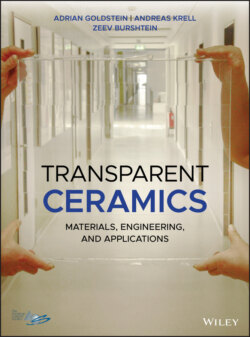Читать книгу Transparent Ceramics - Adrian Goldstein - Страница 21
1.4 Definition of Transparency Levels
ОглавлениеBesides the transparency term describing the nature of light crossing through a ceramic material, an associated translucency term is often used. Both terms describe the same physical process, indicating difference only in the degree by which an incident light beam preserves its ordered properties upon interaction with a transmissive solid.
Figure 1.2 Transmission range of a few transparent ceramics and glasses shown by the aid of optical spectral curves. 1, Fused silica glass; 2, borosilicate glass; 3, MgAl2O4 ceramic; 4, AlON ceramic; 5, submicron alpha alumina ceramic; 6, yttria ceramic; and 7, ZnSe single crystal/ceramic.
Any light beam incident on a highly polished ceramic plate undergoes reflection at the plate surfaces, possibly in bulk scattering and absorption and what remains is transmitted. Each process may be described by a parameter defined as the ratio of its intensity relative to the incident beam intensity.
Transparency: A solid is defined here as transparent if it allows the formation of a clear and undistorted image on a screen (practically a human eye retina) by light emanating from an object and passing through the solid. Transparency requires that a considerable fraction of light emanating from an object point crosses undistorted through the solid. Any light crossing the solid classifies into RIT and “diffusely forward transmitted.” Together with the RIT, they form the total transmitted light (TLT). If scattering occurs, then scattered light is divided between forward- and back-scattered. Only the RIT fraction contributes to formation of a clear image, namely, transparency. Transparency experimental characterization requires discriminating the in-line forward transmitted intensity from the diffuse one. Technically, this means that spectral measurements using sensors of less than 0.5° angular resolution need to be used for the RIT measurements. The main factors determining ceramics optical transmission are the chemical constituent material and crystalline structure. Second in importance is light scattering owed to the presence of second phases and/or birefringence in the constituent material. Lower scattering improves transmission. Absorption is also a deleterious factor, but in most cases, optical absorption may be kept sufficiently low to make its effect negligible.
Translucency: The term translucency is a qualitative term, with the connotation of low to moderate transparency. It implies the existence of a considerable diffuse component in the transmitted light intensity; the total transmission is then usually also quite low (but not in all cases). It is impossible to unequivocally distinguish between translucency and transparency merely by the experimentally measured transmission. It was proposed to label a material “transparent,” over a certain spectral range, when its in-line forward transmission (RIT) is larger than about 65% for a 2 mm thick plate [K56]. It is quantified as only translucent, if the in-line forward transmission is smaller than about 65%, but larger than about 15%. However such limits while practically useful are arbitrary; translucent is a qualitative term. At even lower transmission levels (say, a transmittance of less than 15%), the material is called opaque. A translucent material usually exhibits a relatively low transmission, since the existence of a forward diffuse transmission also entails considerable backward scattering. While the former may exceed the latter, the ratio cannot be too high. Simplified, rather quick laboratory practices are common for gross assessment of ceramic transparency/translucency. The studied ceramic is machined as an optically polished plate, several millimeters thick. One then looks by the unaided eye through the plate onto a printed, well-illuminated text, with the sample positioned about 2 cm above. Such visual inspection is quite useful, in practice, to discriminate between translucent and transparent samples (Section 3.2.3): thin translucent and transparent plates may look similar if the sample position is intimately close to the text, but it blurs with distance for a translucent plate. Visual inspection of specimen thickness variation on the printed letters resolution is also a good approach to compare transparency levels. For highly transparent samples, thickness produces only a minor effect; it leads to gross distortions and clarity loss, if the sample is only translucent.
